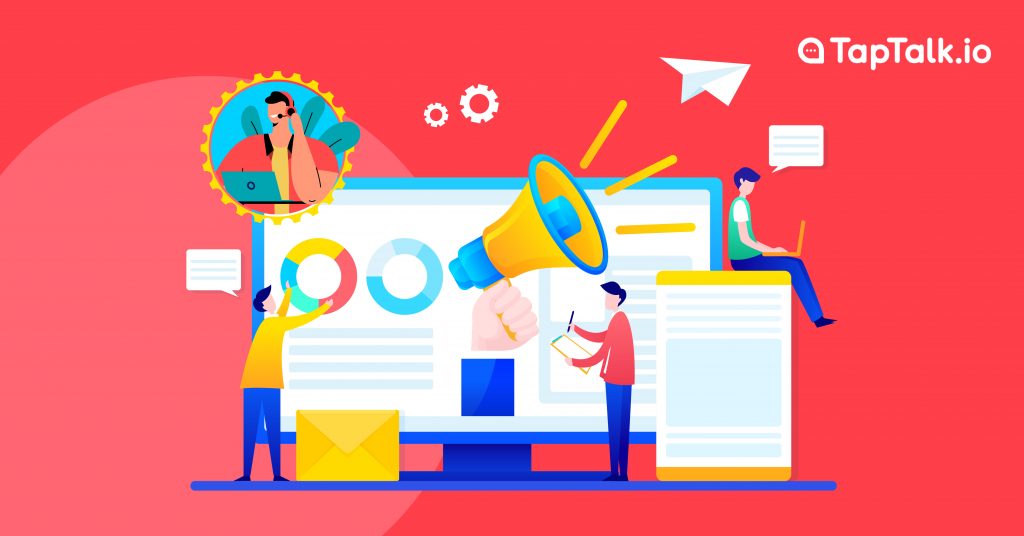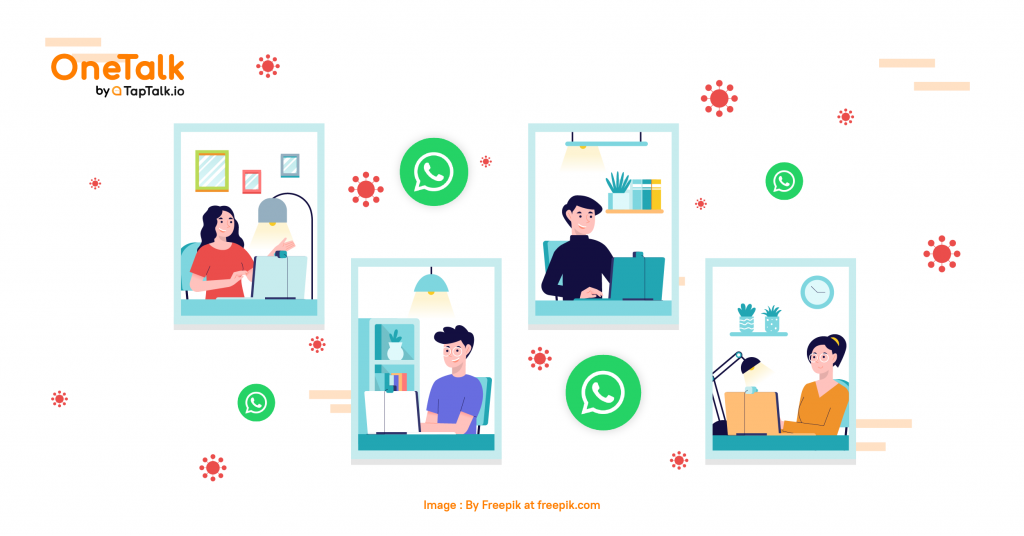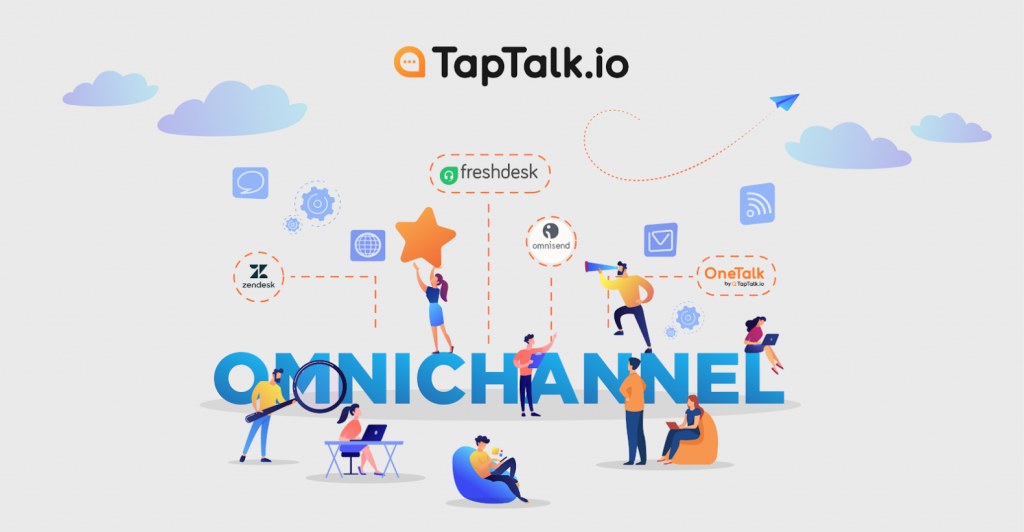
In today's intensely demanding market world, customer service is a practice that should be top of mind for any employee at every business. Of necessity, a customer service team's main aim is to attract existing clients by making them satisfied. However, offering outstanding customer support requires more than just answering questions and addressing concerns.
Customers would focus on solving their issues on their own if they can do it easily and thoroughly. When a customer has an issue with your product or service, the first thing that comes to mind isn't to call you.
According to Dimension Data, 73% of customers choose to use a company's website for help, instead of using their social media, SMS, or live chat. Rather than dealing with a customer service agent, they now want to look for answers online through a FAQ post or an information base.
This kind of behavior causes companies to implement a self-service system. Self-service would be the most effective way to resolve issues because they don't have to wait for the company to answer. There are many ways to use customer service as marketing content:
1. Use Frequently Asked Question
Many of the questions asked by customers are usually repeated. And the answers to these often asked questions are a gold mine with content marketing opportunities.
You can create content such as FAQ forums to help customers with the same issues. For example, Amazon has a system where they strive to stop answering the same question twice. They gathered feedback from all of their customers so they can address the same issue that’s been happening to all of their customers.
2. Use Customer Review/Rating
You can use customer testimonials and ratings as sales materials. According to Wyzowl, 9 out of 10 people value what customers have to say about a company rather than what the company thinks about itself. And according to Spectoos, consumers are more likely to pay 31% more on a company that has positive consumer testimonials.
People trust feedback just as much as they trust personal endorsements from friends and family, but as long as you have outstanding customer service, you will benefit from good reviews online and include them in your numerous onsite and offsite advertising activities. This will prove that you care for your customers and at the same time endorsing your brand.
3. Create a Customer Service and Content Marketing Hybrid
According to The Center for Generational Kinetics, you can create an easy-to-navigate self-help video library. Begin by going through the most popular questions or issues that customers carry to you, and then make a short video that demonstrates how to resolve each one. This may include instructions on how to create an online account, upgrade a battery, or swap a previously purchased item.
Use informative titles for each video so that customers can type in a particular query and get tips that are important to their search. The most important thing is that the videos contain basic step-by-step instructions and can be watched on any mobile screen. If you want to take things a step further, ask your customers to submit their own how-to videos and award awards to the best. In that way, you can kill two birds with one stone.
These aren't the only ways to use customer support in a marketing sense, but they're among the most practical and efficient.
You can use OneTalk by TapTalk.io to help you create great marketing content. One of their useful features is Case Detail. It allows you to know the history of your customers and help you to handle it at a later date. By doing so, you can collect your customers' frequently asked questions and then create an information base or FAQ forum. This feature also helps you find out how long a client has been waiting for a reply, their case history, the channel they use, and much more.
They also have another feature that can help you regarding the same issue. It’s called Topics. With this feature, you can separate cases according to the topics you have created. This helps you to navigate how many issues your customers have in common. You can also use it to customize the incoming case according to the right agent based on their respective department. This way, your customers can quickly be served by the right people.
Combining customer service and marketing results in enhanced organizational communications and clear messages through the business. If the two teams interact, the customer service department is aware of the exclusive deals or content that the marketing department is pushing and may direct customers to. Customer service as a marketing content encourages cross-departmental teamwork, which is just what you get when you incorporate it into your overall marketing strategy.
**For more information about OneTalk and SendTalk, do not hesitate to contact the team by WhatsApp or email!

Given their access to critical market and buyer data, CMOs play a particularly important role. CMOs can bridge the gap between marketing and sales by gathering the most valuable information for sales and providing it to them in an easily digestible format. Bridging the gap between the two will generate more revenue in the long run.
However, in this year, businesses will be under more pressure than ever before to increase revenue. It has infiltrated the re-evaluation of all operations with the goal of determining what actually raises the revenue. This means that everyone in a company is now responsible for revenue in some way.
Those who related in this area will be a part of marketing's shift from sales support to revenue accelerator.
The pandemic has accelerated digital transformation, such as the use of AI, bots, and others. Because your teams and buyers are now all remote, solutions must be built to operate online and rely on technology such as artificial intelligence to allow your teams to focus on revenue-generating tasks.
The CRM that we know is being phased out in favor of dynamic conversation models that aggregate data, infer conclusions, and require less human management. Because everything uses data and AI, it may result in job displacement.
But, there’s no need to be worried, displacement does not always imply destruction. While administrative tasks like email databasing and CRM data logging will be replaced by A.I., the result will be a complete reorganization of how we view work, resulting in new opportunities that require creativity, agility, critical thinking, and emotional intelligence that only a human can provide.
The pandemic has compelled B2B buyers and sellers to go fully digital. Prior to Covid-19, most salespeople relied on high-touch tactics to close deals. Such as business lunches, live entertainment, and plenty of face-to-face interaction. Even if you weren't dining, you were probably flying from one location to another for a one-hour meeting.
According to Mckinsey & Company, all of those traditional approaches will no longer work. It is because the pandemic has changed everything, which has forced a high-touch process to become digital-first. This has accelerated the third marketing era, in which brands must meet customers on their own terms and learn to close deals in a purely digital environment. Even if we are able to reassemble in a safe manner, there is no going back to the way things were.
Increased customer expectations, massive technological advancements, and the rise of omnichannel commerce are just a few of the sales trends reshaping the industry.
According to Mckinsey survey, these pandemic-induced trends are expected to become permanent. It is clear that companies must consider how they will transform the in-store experience by utilizing emerging technologies and big data on customers. Customers want their shopping experience to be personalized in some way, and research shows that effective personalization can boost store revenues by 20-30%.
To serve today's highly digital, well-informed customers, stores are increasingly expected to provide a wide range of omnichannel services, i.e., services that can be accessed through multiple channels. Many consumers, for example, use a variety of channels to gather product information before making a purchase.
As omnichannel shopping becomes the new norm, consumers and retailers must be prepared to provide fast, flawless omnichannel delivery. OneTalk by TapTalk.io is one of the omnichannel services that you can use. They provide many channels, such as WhatsApp, Telegram, Twitter, Line, and Facebook Messenger. The use of this technology has provided easier communication and sales transactions
With OneTalk, you can answer all chats from your customers on various platforms in one inbox. Your customers can buy, ask questions, and get answers online without any hassle by coming to your physical store. By doing so it will provide a much easier transaction because everything can be done online. Other than that, you can also monitor how your agents attend customers.
If 2020 has taught us something, it's that you never know what's around the corner, but these movements are all about being adaptable and easy to adjust. Hopefully, these projections can help you prepare for the year.

It is a well-known fact that COVID-19 will change the world like never before. Businesses have spent most of the last year struggling to adjust to unusual circumstances. Although the battle against the COVID-19 pandemic has not yet been fought, with the vaccine in sight, there is at least a faint light at the end of the tunnel—along with the expectation that another train is not coming our way.
The year 2021 will be the year of transformation. In the absence of any unforeseen disasters, people, industries, and culture will begin to look forward to shaping their future rather than just running through the moment. The next normal thing is going to be different. It's not going to be going back to the terms that existed in 2019. In fact, just as the words "prewar" and "postwar" are widely used to define the 20th century, generations to come are expected to address the pre-COVID-19 and post-COVID-19 periods.
With 2020 closing by, small businesses are hopeful that 2021 will be a brighter year. While the pandemic has been front and centre since the beginning of last year, there are other developments on the horizon for entrepreneurs to watch as well.
In the aftermath of the COVID-19 pandemic, consumers are paying a steep financial toll, and the Canadian Imperial Bank of Commerce (CIBC) is setting itself apart with its financial assistance for hard-hit clients. The bank launched the 'CIBC Pace It' initiative, which provides no fees and low interest on credit card transactions over $100, with installment plans now available. Multiple installment plans can be set up and handled, with payment periods ranging from six to 24 months and interest rates ranging from 5.99 percent to 7.99 percent a year.
Starling Bank, a British fintech firm, recently launched a new digital banking Toolkit as well as a US dollar account. The new tools were created in an attempt to assist British small and medium-sized business owners in managing their finances as the economy slowly recovers.
The new account allows business owners to spend directly in pounds and dollars with a single debit card, create, send and track invoices, automate expenses, record VAT, and connect with HMRC to submit VAT returns. Moreover, the account enables customers to upload bills and schedule payments to manage cash flow.
Starling Bank revealed that Toolkit will be free for the first three months for customers who sign up before July 31, 2020, to assist companies with their post-COVID recovery.
In the aftermath of the COVID-19 pandemic, the grocer's healthcare division has unveiled the Kroger Health COVIDCare Plus initiative to assist companies and brands in returning to normal business operations.
The COVID-19 Home Collection Kit, which allows an individual to conduct a self-administered test and communicate directly with a licensed healthcare professional for supervision, is at the core of the employer-focused program. The program seeks to improve a company's ability to have workers tested in order to prevent the spread of disease and provide them with peace of mind.
Many health authorities have now approved rapid COVID-19 testing, and companies are now considering offering it as a service to their customers. This makes sense for airlines, particularly because the outbreak has had such a significant effect on the industry.
According to Reuters, German airline Lufthansa has included rapid COVID-19 testing in their passenger kit. The test will be open to first-class and business-class passengers starting in October. This is due to the fact that test availability is limited.
Uber for Business recently announced the introduction of a new Uber Eats platform that allows companies to customize meal plans for their employees and consumers. The new vouchers can be used for anything from single lunches to 1,000-person virtual events. The program is managed through a dashboard that allows employers to tailor their employees' meal spending by setting start and end dates for vouchers, limiting the number of orders, and keeping existing features like ordering times and spending caps in place.
These granular offerings allow companies to easily meet the needs of both their workers and prospects as working from home becomes a future, even as economies slowly reopen.
The 'Sellerium' platform seems to be a solution for eCommerce professionals that gives them access to a wide range of analytics that they can use to improve their company. Professionals will have access to tracking statistics for 20,000 vendor groups and more than 10 million items across the app, which will be used to control listening.Sellers can then adjust to the evolving demand to increase sales, or even pivot their current goods to cater to a particular customer need.
The 'Sellerium' platform will also provide a listing SEO review, which will look at the bullet points and details while also checking for any inconsistencies or inappropriate language.
Tutor Doctor, a prestigious tutoring company established in 2008 with over 90,000 highly trained tutors, has introduced new e-learning capabilities to assist families through the daunting changes of the "new standard."
The company caters to students of all ages, from elementary school to university, and helps them succeed in their studies.
Students are matched with a tutor based on their needs and given a "tailored learning plan suited just for them" by the new online tutoring resource, which provides the same attention and commitment as an in-person tutor.
Tutor Doctor is available in 16 countries, including the United States, Canada, United Kingdom, Ireland, Ecuador, Australia, Mexico, Chile, Costa Rica, Peru, Panama, Guatemala,Nigeria, Tunisia, South Africa, and Columbia.
The 'Maya' AI business bot is a virtual solution for entrepreneurs that will assist them in automating some of their workflow in order to save time on unique tasks. The artificial intelligence (AI)-powered solution works by assisting with operations and R&D, allowing the entrepreneur to concentrate on the overall growth of the company. This could help them cut down on the amount of hours they spend coping with day-to-day activities, allowing them to concentrate their energy on more important tasks.
The 'Maya' AI business bot is one of an increasing number of AI-powered business solutions that help entrepreneurs spend less time on tasks that are necessary but not relevant.
With the spread of COVID-19 keeping many people from eating out, the ghost kitchen would allow restaurant to serve customers in the area without having to invest in a costly physical venue. Customers can order from the ghost kitchen by going to their preferred participating app and selecting the things they want delivered.
In the United States, Red Lobster is expanding its menu to include a new ghost kitchen in Chicago, where customers will be able to order their favorite Red Lobster dishes from third-party delivery services such as UberEats, GrubHub, and Postmates, as well as DoorDash.
"Red Lobster places a high value on off-premise dining. In the two years leading up to COVID-19, we tripled our off-premise revenue, and we've tripled them again in the last eight months. The next logical step in growing our off-premise company is to open a ghost kitchen. It will allow us to reach out to new customers who are looking for great seafood and a hassle-free off-premise experience." CEO Kim Lopdrup said of the company.
In this pandemic era, people are beginning to keep their relationship with customers close and smooth. Applying good quality customer service seems to be a priority in some cases. But for those who are having a hard time keeping those relationships with their customers because the high flow of the message coming to the company is too much, there is a solution.
The omnichannel messaging platform is all the hots for 2021. Omnichannel can integrate multiple messaging channels and put them on a Single Dashboard so you can see all the messages from all your messaging platforms.
This will be useful for business because you can also monitor your customer service agent when they work. But this all will be possible with a trusted omnichannel brand, OneTalk by TapTalk.io.
OneTalk offers a good deal for you in turn of so many amazing features that could help your business. Starting from Real-Time Agent Activity Tracker that could track you agent performance, Disposition that can see the analytics of your interaction with customers, and you can even use WhatsApp Business API services without a hassle of the registration.
With people trying to cut cost to all unnecessary spendings, using WhatsApp as a platform to send One-Time Password will be better in all accounts.There are a lot of proofs that said WhatsApp based OTP is more secure than that SMS-based OTP.
Many experts admit that sending an OTP code via WhatsApp is safer than using an SMS-based OTP. SendTalk offers more consistent delivery. A more conventional way of sending notifications via SMS or Call relies on a cellular signal. You can get faster delivery times via WhatsApp. No more problems with mobile providers.
With a lower cost compared to the SMS type OTP, SendTalk will be more profitable than the SMS-based OTP service. With SendTalk, imagine how much money you could save, instead of using an SMS-based OTP which costs from Rp350,00 to Rp500,00. The rates offered by SendTalk are certainly more affordable than SMS-based OTP.
The COVID-19 pandemic has wreaked havoc on the economy and on people's lives, and it's far from finished. However, with the launch of vaccines, it's possible to be cautiously hopeful that the new standard will emerge this year or next.
And we agree that normal could be better in certain ways. The changes we described—in efficiency, green development, medical innovation, and resiliency—could provide an enduring framework for the long term with good leadership from both businesses and governments.
**For more information about OneTalk and SendTalk, do not hesitate to contact the team by WhatsApp or email!

What are the steps to starting a business? There are thousands of websites, including ours, that provide checklists to remind you of the various tasks you must complete when starting a company. These checklists are simply To-Do lists, despite the fact that they are really helpful in helping you remember important startup steps. They tell you what to do, but they don't give you any advice on how to run a successful company.
Of course, we all want to make millions of dollars. But what are you willing to sacrifice in order to achieve that goal? How many hours a week will you work continuously? How far do you want to stretch outside your comfort zone? How far will your family grow with you? To be successful, keep your business plan in line with your personal and family goals and resources.
The old formula - find a need and meet it - still works. It will always work. The key to success is finding a need you can meet, that you want to meet, and that will generate enough income to build a profitable business.
One of the most common mistakes startups make is believing that a large number of customers will choose to buy a product or service simply because the owner of the company likes the idea or knows one or two people who did it. To minimize your risk of loss, never assume that a market exists. Research the idea. Talk to real prospects (who are not family and friends) to find out if what you are trying to sell is something they will be interested in, and if so, how much they will pay for the product or service.
If you want your company to be a long-term success, you can't afford to focus on a tiny customer base to get you there. If you depend so heavily on one or two clients, you will still be at risk of losing badly if you lose one of them. Ideally, you will have a broad client base covering different customers in a variety of industries and locations.
You will face competition no matter what form of company you start or run. And if no one else is doing what you do, your potential buyer will almost certainly use a different product or service to meet their needs. To be successful, you need to research the competition and find out as much as you can about what they sell and how they sell it. Competitive research is something you should plan to do on an ongoing basis too.
One of the other best business tips and tricks is always to plan ahead. You don't want to get caught up in the hop by changing market forces or by other issues that could have been anticipated and taken into account. Just by keeping an eye on the future, you can always remain in control of your own destiny.
You don't need a complicated business plan if you're not looking to invest or invest a significant amount of money in your company, but you do need a plan - a plan that outlines your goals - your goals - and then establishes at least a road map outline for how you will get there. . Strategy will evolve as you gain a deeper understanding of your customers and competitors, but it will also help you stay focused and on the right track. To help create a basic plan, use our business planning worksheet.
Most people who are thinking of starting a business focus on what they will sell and who they will also sell. What they often don't consider is how the business will actually operate. For example, if you sell an item, how is it delivered? How much customer support will be needed - either to answer a question about a product or to respond to a delivery person who hasn't arrived? Do you need to accept credit cards? Will you bill customers? Who will follow up to make sure you get paid? Even if you are starting a small personal service business, this is an issue that you should consider and plan for.
I have heard several people advise potential business owners not to continue with their business until they have investigated every last detail of the business they want to start and are absolutely certain it will be successful and profitable. The problem with that approach is that it leads to procrastination. Nobody really owns all the pieces - even after they've started their business. Yes, you need to research the market, have a rudimentary plan, and do things like getting a tax ID if needed, register with local officials, if needed, etc. But if you try to make everything perfect before launching, you may never be able to start your business at all.
Some people believe that entrepreneurs are risk-takers. But for the most part, successful entrepreneurs don't like walking blindfolded. Instead, they take controlled risks. They test an idea on a small scale, then develop it
The distinction between successful individuals and the rest of society is that successful people learn about their mistakes and move on. They don't dwell on their shortcomings, blame the economy, curse their poor luck, or put blame on others. If the path to their target is blocked, they attempt an alternative route or, in some situations, select a more attainable goal.
Find a mentor, attend a like-minded community, learn all you can about the profession and how to get from where you are to where you want to be. Attend industry-related activities. When training opportunities arise, take advantage of them. Purchase expert-led courses. Even if you reach a certain level of success, you shouldn't stop looking for fresh new ideas that can take your business to the next level. You may be able to enter a new industry, use the latest technology, or simply take a new path to what you have always been doing. The most popular companies are still looking for fresh ideas and practical business tips and tricks they can use.
Track income and expenses, keep business and personal money separate and find the rules your business must adhere to.
If you want to start a business, then you need to develop systems and methods that will allow you to hire other people to do the project work according to your plans. You limit your growth potential if you don't get other people to work for you.
If the business you're starting needs investors to grow, do your best to find out what investors are looking for and where to find who might invest in your type of business. Local owners and venture capital groups are a good place to start - attend the meetings they are hosting or the meetings investors are talking about. Get a promotion so that it can be used to attract investors if you get the chance.
Ask what you want (politely.) I started my online business by participating online at GEnie GE's online service. When I am ready to send them a proposal to run a small business area, I can not only talk about my credentials in general, but I can also point out the places where I have contributed their services. I became one of America Online's premier content providers because I picked up the phone and put on a cold call. I ended up with a new consulting agency after I had started a conversation with a woman sitting next to me on the plane. Remember, people love interacting with people they know. Start rolling the ball and keep it up by continuing to communicate and introduce yourself to new people.
Even if you run a local business, you need an all-around digital presence. At a minimum, you need a website that looks professional, an email list that allows you to communicate with customers and prospects on a regular basis, and a presence on the social media channels your customers visit.
If you just stand still then you open yourself up to the risk of others overtaking you. You can use social media to find new ideas and trends to follow. Consider using a social media tracking and monitoring tool to see what your customers and competitors are saying about you and the industry in general on social media.
What is profitable now is not necessarily profitable in the next year or 10 years from now. So don't let yourself fall into the "This is how I always do things" habit. Open your eyes and ears to new things. Are there newer or better ways to market your products and services? Are customers asking for something you don't offer? Are there different types of clients you should target? Get answers by reading everything you can about your industry and listening to your customers.
Doing those 16 tips sounds like a great hassle, is it? But, you don’t need to worry about how hard it is. You can actually make your business succeed by improving your customer service. By doing this, you develop a great relationship with your customer, and in turn, you can achieve loyal customers.
OneTalk by TapTalk.io is an omnichannel messaging solution that integrates multiple messaging platforms for your business. Using WhatsApp Business API with multiple agents and at the same time, integrating other messages in other platform is possible with OneTalk.
OneTalk takes the hassle out of answering your customers across multiple platforms because OneTalk provides a faster way to respond to your customers which can increase your future sales and marketing. With OneTalk, you can reach customers who work from home from various messenger applications and vice versa. Your customers and customers can shop and ask and answer online hassle-free with the OneTalk omnichannel from TapTalk.io.
Your business can runs smoothly and provides world-class service with our products. OneTalk is at your disposal, with just one dashboard for all your messenger accounts. Monitor messages from WhatsApp, Telegram, LINE and more, on one dashboard.
OneTalk removes the boundaries between different sales and marketing channels to create a complete and integrated whole. The differences between the channels on-site, social, mobile, email, physical, and instant messaging disappear when one customer view and one shopping experience appear.

The ongoing COVID-19 pandemic storms have proved to be very effective in significantly changing consumer behavior. Most of the middle class and above (the middle class) withhold spending or spending in response to economic uncertainty and the risk of recession.
The impact of this behavioral change is very clear, household consumption spending has fallen sharply and has contributed significantly to the decline in economic growth in the second quarter and will continue in the third quarter. Even the IMF has officially stated that the COVID-19 Pandemic has become a global economic crisis marked by many countries on the brink of recession.
Given that the COVID-19 pandemic is forcing people to stay more at home so as not to catch the virus. Most of the activities take place online at home, both work, school and shopping. Business players are expected to learn digital marketing strategies to advance their business in a pandemic like this.
This is the right moment for business owners to maximize the marketing process with the help of digital marketing or online marketing services that will deliver a lot of benefits. Commercials in national media will make the product better known to the public. Given that in this digital era, competition is getting tougher. The number of e-Commerce is a breath of fresh air for online businesses.
Doing business through online is actually not difficult. As long as you master the market and have a good digital marketing strategy, the business will continue to exist. Supported by current conditions, more buying and selling activities are carried out online.
Online business requires you to master digital marketing and social media. If it is too difficult to learn, you can go to digital marketing services or other third party services that could help you with your sales.

The first strategy that you can adapt to your business, is to make the products or services that you sell easily accessible and affordable. For example, by providing easy payments, extending installment periods, reducing down payments, reducing packaging and increasing the number of payment options.
With this first strategy, even when customer purchasing power is declining, you don't need to reduce prices too drastically. This is because it's going to make cash flow critical. Conversely, this strategy will make your product or service appear friendly and empathetic to the financial condition of the customer, which is generally very difficult in a pandemic like today.
The second trendy sales strategy is to develop a more specific and unique customer segmentation. For example, you can make customer segments on the basis of their purchasing power, taste, where they live, and perhaps on the basis of their consumption behaviour. Performing Customer Segmentation will enable us to target customer targets with greater precision and matching accuracy.
The request, for example, is that you provide special discounts for fishermen's customers, workers' customers and informal workers who are currently struggling with purchasing power due to their reduced income. This second strategy has the power to keep cash flow even though the profit margin is declining, but not until it is completely eroded.
The third Strategy is the Green Ocean Strategy. This strategy works by increasing the sales reach and distribution of new markets that are more potential and still competitively silent. This strategy is generally used by companies that have experienced saturation, aka stuck with a specific market or target customer, or it could be that your company is experiencing regulatory barriers that are making revenue worse. It is therefore advisable to find new areas with regulations that are more friendly and business-friendly.
Expansion is an example of the application of this strategy, which means enlarging the sales pie by targeting new markets or areas that are still green, or by shifting production to goods that are urgently needed by the community during the COVID-19 pandemic. The latest example is some entrepreneurs who started working on the production of PPE, masks and hand sanitizers at affordable prices and maintained quality, at the same time they moved to open the market for herbal products such as herbal medicine, which turned out to be greeted with great fanfare and generated luxurious sales and were able to help. People who need support to increase immunity. So it turns out to be convincingly proven that even in difficult times like now, you can avoid bankruptcy or get stuck with complicated debts and don't have to run around chasing credit-collecting bandits.
The fourth strategy that you can use to keep the business alive in times of crisis, is called the Narcissistic Selling Strategy. Namely, increasing the availability (availability) of your product or service at every corner of the opportunity in the market, both the conventional market (offline) and the online sales platform.
That is, how can your product be everywhere, easy to find even in unexpected locations. This is very important because during a pandemic, customers are generally too lazy to go far to get the goods or products they are looking for.
But if it turns out that you are able to make the product or service narcissistic, then this is really beneficial for the product to be purchased immediately because it is easy to find, especially if it turns out that the product has a price that is easily accessible to customers, such as in the First Trendy Sales Strategy.
So how do you keep your products and services narcissistic and exist in most markets or sales platforms? It's very easy and there are many alternatives, the choice that is often used is to do a partnership or deposit goods. Another name is consignment. This fourth strategy, when combined with the three strategies above, will certainly have a tremendous impetus for increasing your sales.
The fifth or last strategy to increase sales during pandemic is the Humble Strategy. Maybe you are not familiar with this term, but I am sure that you will understand how it is implemented after this article.
This fifth strategy explains how the products and services that you market are easy for customers to feel and touch. So, they first feel the benefits and differences and the value that will be obtained from these products or services before finally deciding to choose or buy.
What is an example of this understated strategy? Recently a lot of people opened online training classes for free or for free. The goal is none other than so that some prospects, prospective clients or even existing clients gain insight and benefits about the new training module The 10 Habits of Highly Productive People. As a result, after participating in the free training, prospective buyers become aware and know that they need the product or training module, so for the second pull of course they have to buy and pay.
These five effective strategies are developed in such a way that to ensure that even in the challenging conditions during the pandemic, you are still able to survive and even grow sales, so that you can successfully pass through these difficult times with confidence.

Besides strategy, there is one more addition you should have in your sleeves to boost your sales. Can you guess what it is? Yep! Customer Service. Great customer service is a requirement for a smooth online transaction because there is practically no human interaction face to face. So you should support all your customers’ needs with a balanced customer service. Your agent or your representatives should have a great knowledge about your product and exudes sympathy and empathy when they serve your customers.
Omnichannel can help you serve better customer service. This service helps you build a good relationship between you and your customers virtually. OneTalk is an Omnichannel Customer Engagement product from TapTalk.io that could integrate multiple messaging platforms for your sales, marketing, and support.
When you need to be a proactive party to your customers, you can reach them first with the Start New Conversation feature that allows you to start a case so that your business can reach your customer first. You can use this feature just by entering your destination number.
But worry not! There are a lot of features that could also support your business so that it could enhance your customer service. Messages and complaints are integrated in a Single Dashboard, so this makes your customer service easy to manage. Various messaging platforms are supported with this service so your agent (or even agents!) can immediately answer them. Supported platforms in OneTalk are Telegram, LINE, Twitter, WhatsApp, e-mail, etcetera.
OneTalk also enables you to reach your customer all at once with the Broadcast Message feature. This will allow you to send messages to multiple recipients and even support various types of files, such as Images and Videos.
If you want to delve deeper with our feature, contact our agent and ask everything you want to dig. We will anticipate your messages!

Sekarang, semakin banyak perusahaan yang berfokus pada peningkatan pengalaman pengguna dengan menggunakan omnichannel. Berdasarkan survey, perusahaan yang menggunakan Omnichannel sebagai strategi customer engagement akan mempertahankan rata-rata 89% pelanggan mereka. Gaya pemasaran ini menciptakan banyak kesempatan bagi pelanggan untuk membeli lebih mudah karena memudahkan pelanggan untuk berkomunikasi melalui channel yang mereka punya.
Banyak brand besar seperti Disney, IKEA, Sephora, dan lainnya telah menggunakan omnichannel dalam bisnis mereka. Sebagian besar pelanggan lebih memilih perusahaan yang memanfaatkan omnichannel karena hal itu memungkinkan mereka merasa seolah-olah bisa mengendalikan pengalaman mereka, lebih menghemat waktu, dan bebas memilih channel ketika ingin berkomunikasi.
Sebelumnya kami pernah membahas Omnichannel. Singkatnya, Omnichannel adalah penyatuan beberapa channel dan sebuah strategi komunikasi sehingga mereka saling melengkapi untuk memberi pelanggan apa yang mereka butuhkan. Omnichannel menempatkan pengguna Anda di pusat segalanya.
Sebagian besar perusahaan berinteraksi dengan pelanggan mereka di banyak channel. Channel ini termasuk toko online dan fisik, media sosial, mobile application, dan banyak lagi. Dengan Omnichannel, semua channel komunikasi ini saling bekerja sama untuk memberikan pengalaman yang terintegrasi sepenuhnya.
Terdapat beberapa keuntungan yang bisa Anda miliki jika menggunakan Omnichannel, yaitu
Umumnya, omnichannel menawarkan fitur yang memudahkan Anda untuk memperoleh data pelanggan seperti history belanja mereka
Berdasarkan data yang sudah diperoleh sebelumnya, Anda bisa mengetahui perilaku pelanggan Anda seperti apa. Dengan begitu, Anda bisa merencanakan kampanye yang lebih sesuai untuk mereka
Anda bisa mengatur pesan yang masuk dan menyesuaikannya dengan agent yang akan menanggapinya. Hal ini akan meningkatkan efisiensi operasional karena setiap agent hanya akan menanggapi kasus berdasarkan bidangnya
Dengan menggunakan banyak channel, brand Anda akan sering dilihat oleh pengguna yang juga memiliki banyak channel. Hal ini akan meningkatkan kepercayaan dan mendorong mereka untuk berbelanja di bisnis Anda
Di Internet, Anda bisa menemukan berbagai macam penyedia layanan omnichannel. untuk mempermudah Anda, kami telah mengumpulkan beberapa penyedia layanan omnichannel terbaik untuk Anda. Berikut adalah beberapa penyedia omnichannel yang dapat Anda pilih.
Omnisend adalah omnichannel yang dibangun untuk e-commerce yang berfokus pada pertumbuhan. Mereka memiliki 5 channel yang bisa Anda gunakan, yaitu email, SMS, Web Push Notifications, Facebook Retargeting Sync, dan Google Retargeting Sync.
Melalui channel email, Anda dapat membuat kampanye profesional yang dipersonalisasi menggunakan fitur pemasaran email. Mereka memiliki beberapa template yang dapat Anda gunakan seperti email otomatis, newsletter, dan email transaksional.
Selain itu, mereka juga dapat menganalisa dan membuat laporan dari penjualan dan metrik kinerja Anda. Melalui data ini, Anda dapat mensegmentasikan pelanggan Anda berdasarkan item yang mereka beli, rata-rata jumlah pesanan, dan banyak lagi.
Omnichannel Zendesk menawarkan solusi yang memudahkan pelanggan untuk terlibat dengan bisnis Anda, dimanapun atau kapanpun sesuai dengan keinginan mereka. Channel yang dimiliki Zendesk adalah WhatsApp, Facebook Messenger, Twitter, LINE, dan WeChat. Mereka juga memiliki fitur live chat untuk menjangkau dan berkomunikasi dengan pelanggan bahkan sebelum mereka mengajukan pertanyaan.
Zendesk memiliki sistem tiket yang menempatkan email, obrolan, sosial, dan suara di tempat yang sama, sehingga bisnis Anda dapat lebih fokus pada percakapannya. Zendesk memungkinkan Anda mengakses data pelanggan agar Anda bisa menganalisisnya dan mengembangkan pengalaman terbaik bagi pelanggan Anda.
Freshdesk adalah sistem helpdesk berbasis cloud yang menawarkan solusi untuk layanan pelanggan. Freshdesk menyatukan percakapan dari email, live chat, telepon, web, dan media sosial, dan membantu Anda menyelesaikan masalah di berbagai channel dengan mudah.
Mirip dengan Zendesk, Freshdesk juga memiliki sistem tiket. Tiket dari berbagai channel akan masuk ke dalam satu inbox. Mereka juga memiliki laporan analisis untuk mendapatkan gambaran instan tentang kinerja helpdesk Anda, kebahagiaan pelanggan, dan kinerja tim Anda.
OneTalk merupakan produk Omnichannel Customer Engagement dari TapTalk.io yang bertujuan meningkatkan efisiensi dan kualitas hubungan bisnis dengan pelanggan Anda.
Channel yang dimiliki OneTalk adalah WhatsApp Official Business API, Facebook Messenger, Telegram, Twitter, dan Line. Semua channel ini akan digabungkan ke dalam satu inbox. Melalui OneTalk, Anda dapat mengakses data pelanggan dan menganalisanya agar Anda bisa memahami pelanggan lebih dalam, seperti kebiasaan, keinginannya, dan lainnya. Selain itu, Anda juga bisa mengirimkan pesan otomatis ketika pelanggan menghubungi Anda di luar jam kerja.
Harga Omnisend mulai dari $16 USD atau setara dengan Rp260.000 per bulan, tetapi mereka memiliki versi gratis juga. Omnisend menawarkan 14 hari uji coba gratis.
Harga Zendesk mulai dari $5 USD atau setara dengan Rp70.000 per bulan, per agent-nya. Mereka tidak memiliki versi gratis. Zendesk menawarkan 30 hari uji coba gratis.
Untuk layanan omnichannel, harga Freshdesk mulai dari $99 USD atau setara dengan Rp1,39 juta per bulan. Freshdesk menawarkan 21 hari uji coba gratis.
Harga OneTalk mulai dari Rp399.000 per bulan dan menawarkan 14 hari uji coba gratis tanpa harus mendaftarkan kartu kredit. Dibandingkan tiga penyedia omnichannel sebelumnya, Anda tidak perlu menggunakan mata uang asing untuk memakai OneTalk.
Setelah mengetahui fitur dan harga tiap brand yang menyediakan layanan omnichannel. Bagaimana memilih provider yang tepat untuk digunakan? Ini adalah beberapa hal yang bisa Anda perhatikan jika sedang mencari provider omnichannel.
Menurut Gartner, 85% pelanggan akan berkomunikasi dengan perusahaan tanpa berinteraksi dengan manusia sama sekali. Jika provider omnichannel yang Anda pilih tidak bot-ready, Anda akan kehilangan satu segmen pelanggan dan kalah dengan perusahaan yang omnichannelnya memiliki bot. Kecepatan pelanggan mengadopsi channel baru semakin meningkat. Anda akan membutuhkan penyedia yang siap dengan cepat mengintegrasikan bisnis ke channel pilihan konsumen.
Anda akan membutuhkan provider yang tidak hanya dapat menawarkan channel baru, tetapi juga dapat menawarkan integrasi yang mulus agar Anda mudah mengoperasikannya.
Ini bukan hanya tentang jumlah channel yang banyak, tetapi jumlah fitur baru yang akan disediakan oleh channel tersebut. Provider yang baik memberi Anda kemampuan untuk memanfaatkan fitur-fitur baru ini dengan mudah dan cepat.
Untuk menawarkan pengalaman yang benar-benar sesuai dengan brand, Anda memerlukan provider dengan interface yang rapi dan kemampuan untuk mempersonalisasi tampilan itu agar sesuai dengan brand Anda. Ini penting karena hal tersebut akan menampilkan citra perusahaan Anda.
Anda memerlukan pelaporan terpercaya yang dapat Anda peroleh dari kejadian nyata. Idealnya, ini harus dimasukkan ke dalam solusi yang ditawarkan provider omnichannel. Dengan data ini, Anda bisa mengetahui lebih dalam tentang pelanggan dan kinerja agent Anda
Anda harus memilih provider yang dapat menyesuaikan dengan kebutuhan Anda. Provider yang sering mendengarkan penggunanya akan memberikan kesempatan bagi Anda dan dirinya sendiri untuk berkembang.
Nah, berdasarkan tips tersebut, Anda bisa memilih OneTalk. Provider ini merupakan salah satu karya anak bangsa, jadi Anda tidak perlu khawatir jika kesulitan dalam berkomunikasi atau melakukan pembayaran. OneTalk selalu aktif mendengarkan usulan yang diberikan penggunanya supaya OneTalk tetap menjadi solusi omnichannel terbaik. Mereka juga menyediakan panduan step by step dan integrasi yang mulus sehingga Anda mudah menggunakannya.
OneTalk didukung oleh interface yang dapat dipersonalisasi sesuai dengan citra brand Anda. Selain itu, Mereka juga menyediakan fitur Disposition agar Anda bisa mempelajari data pelanggan dan mendapatkan insight business

All industries and sectors have been challenged by the COVID-19 pandemic, and higher education has been no exception. In the effects of and response to the pandemic, the diversity of campus cultures, financial health, business models, and students have contributed to a similar diversity. For higher education, there was no pandemic blueprint, and 2020 was a year that needed a decade of commitment and transition.
And still, it will end the pandemic. Epidemiologists will no longer appear on television shows on a daily basis sometime in the future, and public spaces will no longer be labeled with circles every six feet. What is left, what are we going to face on the other side of COVID-19, and what part can technology play in the forthcoming recovery?
We have all developed a new way of thinking about the future after the pandemic. We've discovered the futility of making long-term preparations to alleviate an illness with nuanced and poorly understood signs, diagnosis, medications, and prognoses. Most of us have realized that a pandemic can not be handled successfully by obstinacy, cheerleading, skepticism, and magical thinking. The usefulness of contemplating scenarios and increasing our resilience and versatility has also been taught.
Scenarios allow us to predict possible potential alternatives, so that we are prepared not just for what we may expect or fear, but also for what is actually happening. When situations change and new knowledge comes to light, agility and versatility help us move rapidly and adaptively. Now is the time to understand how the pandemic can bring about higher education and how information technology will help.

We made three assumptions when we considered possible scenarios that could direct the pandemic recovery preparation of an organization.
One or more successful vaccinations will be available and distributed. It would be possible for leaders, students, and other stakeholders to begin preparing for their recovery journeys.
The three examples we have selected are very general and focused on how the vision, culture, and business model of an organization can impact its recovery strategy.
For instance, one scenario may be adopted by leaders to guide financial health and another to guide education and academic work.
The big wildcard for 2021 will be lessons learned by faculty, administrators, students, and the family from the pandemic. If all goes well, students will be pleased to return to pre-pandemic higher education and remain resigned to their costs. If all goes well, administrators and faculty agree on how to integrate online learning into a restored institutional culture.
The pandemic has been a global disaster of unprecedented proportions in our lives. It's going to prove to be an inflection point. With all these said, we will remember life before the pandemic and compare it to a significantly different life after the pandemic. Higher education is not going to be the same. In fact, for some institutions, the pandemic will be an extinction event.
The pandemic will alter our lives, be it at a structural or surface level. There will be many who truly work on revolutionary and financial health or culture aspects.
But the pandemic will result in other institutions to reinvent themselves and start contributing to the epigenetic change of higher education.
With all these changes in every aspect of our lives, now we have to do things with the help of technology because everything is online nowadays.
Using services that could help you with your business or institution may be the thing that you need to consider in these uncertain times. There are three products that were made by TapTalk.io whose sole purpose is to help businesses be more successful in their sales, marketing, and support.
Powertalk by TapTalk.io is a Chat SDK & Messaging API for mobile apps. It is an enterprise-grade chat solution for your mobile apps and websites. With this, you can easily integrate secure and robust chat solutions to your own apps and website with an industry-leading 99.99% uptime SLA guarantee.
OneTalk by TapTalk.io is an Omnichannel Customer Engagement product from TapTalk.io that could integrate multiple messaging platforms for your sales, marketing, and support. OneTalk relieves you from the hassle of answering your customer on multiple platforms because OneTalk provides a faster way to respond to your customer which can enhance your sales and marketing in the future.
Want to ease your curiosity? Contact us by WhatsApp here or by email for more information. We will love to answer all your questions!

Tim sales dan marketing selalu dikenal memiliki hubungan yang buruk karena kurangnya keselarasan kerja. Meskipun kedua tim tersebut memiliki tujuan bisnis yang sama, proses kerja mereka sangatlah berbeda sehingga dapat saling bertumpang tindih bahkan berlawanan.
Tim marketing terkadang menyalahkan tim sales karena tidak memanfaatkan semua prospek atau konten yang mereka buat. Sebaliknya, tim sales berpikir bahwa tim marketing tidak menghasilkan prospek yang siap untuk dijual dan berkualitas baik.
Menurut survei InsideView, ada enam hambatan terbesar dalam penyelarasan sales dan marketing, yaitu
Selain itu, tim sales lebih berfokus pada pendapatan bersifat jangka pendek. Sementara tim marketing lebih fokus pada brand kreatif berjangka panjang, seperti campaign untuk menghasilkan pendapatan.
Namun, sales dan marketing bekerja jauh lebih baik bila bekerja sama dibandingkan secara mandiri. Sudah saatnya bagi mereka untuk saling bekerja sama. Jika mereka dapat bekerjasama dengan baik, tentunya pendapatan akan meningkat.
Menurut HubSpot, ketidakselarasan antara tim sales dan marketing menelan biaya $ 1 triliun per tahun. Namun, HubSpot juga menemukan bahwa organisasi dengan penjualan dan pemasaran yang sangat baik menghasilkan 38% lebih banyak deals dan mencapai pertumbuhan laba selama tiga tahun yang 27% lebih cepat. Mereka juga mencapai pendapatan 208% lebih tinggi daripada organisasi dengan tim sales dan marketing yang terputus.
Masih bingung bagaimana cara menyelaraskan tim marketing dan sales? Anda dapat mengikuti beberapa saran berikut ini:
Konten yang dibuat marketing membantu sales mendapatkan calon pembeli lebih cepat.
Tim marketing biasanya membuat konten berdasarkan analisis pasar dan tren industri, strategi promosi, dan segmentasi kelompok sasaran. Jenis konten ini kemudian digunakan dalam proposal penjualan.
Namun, konten ini baru berdasarkan hasil riset dan data. Maka dari itu, tim sales dapat membantu pengembangan konten. Mereka dapat memberikan insight yang lebih nyata berdasarkan pengalamannya yang langsung berhubungan dengan pelanggan. Butuh komunikasi yang kuat antara dua tim ini.
Sales dan marketing akan lebih selaras jika mereka mengadakan pertemuan rutin untuk membahas visi dan strategi mereka. Menurut Content Marketing Institute dan LinkedIn, sebanyak 73% tim yang sangat selaras bertemu setiap hari atau mengadakan rapat tiap minggu.
Penting juga untuk menganalisis hasil dari satu bulan, kuartal, atau tahunan bersama-sama. Setiap tim akan mendapatkan insight yang banyak berdasarkan tanggapan tim lainnya.
Selain itu, ini bisa dijadikan latihan bonding yang bagus, membantu tim memutuskan mana yang berhasil dan yang tidak.
Hal lain yang sangat bermanfaat adalah mendengarkan masukan pelanggan. Ini memungkinkan kedua tim untuk melihat bagaimana sesuatu berkembang secara real time dan meningkatkan akuntabilitas.
Perbedaan dalam mengukur pencapaian merupakan hambatan serius bagi penyelarasan sales-marketing. Tim sales dapat berfokus pada jumlah akun baru, transaksi yang ditutup, penjualan ulang, dan lainnya. Di sisi lain, marketing dapat lebih menekankan pada kualitas prospek, rasio kesadaran brand, dan perkembangan saluran prospek.
Agar sales dan marketing merasa bahwa mereka bekerja untuk tujuan yang sama, mereka perlu berbagi sesuatu yang nyata - seperti KPI (Key Performance Indicator) atau indikator kinerja.
Menurut Content Marketing Institute dan LinkedIn, tim marketing dan sales dapat selaras jika berbagi KPI yang sama, yaitu memprioritaskan pendapatan dan pertumbuhan.
Penggunaan KPI bersama, dan didorong oleh pola pikir "mengutamakan pendapatan", adalah cara yang bagus untuk menyinkronkan upaya kedua tim.
Bisnis yang sukses selalu tampil sebagai organisasi yang bersatu dan sehat di mana setiap orang berbicara dengan satu suara.
Jika pelanggan mendengar satu pesan iklan (marketing) di media sosial, dan kemudian menerima informasi yang berbeda dari seorang penjual (sales), mereka akan kebingungan.
Hal-hal seperti penamaan produk yang tidak konsisten, penggunaan istilah yang berbeda, dapat merusak reputasi perusahaan secara keseluruhan. Jika sales dan marketing tidak bekerja sama, mereka mungkin, secara tidak sengaja, menciptakan citra brand yang membingungkan. Untuk bisnis yang tidak terorganisir, tentu penjualan akan lebih sulit.
Itulah mengapa sales dan marketing harus memiliki suara yang sama. Mereka harus menyampaikan pesan yang sama dan konsisten.
Salah satu cara terbaik untuk menyatukan tim sales dan marketing adalah dengan memberi mereka alat kerja yang sama, serta membuat kampanye yang bekerja di banyak audiens, berbagai saluran, dan dalam berbagai format.
Sistem omnichannel messaging platform bisa dibilang salah satu alat yang paling cocok dalam hal ini. Omnichannel dapat menyatukan semua aktivitas, dan informasi kontak di satu tempat terpusat yang mudah diakses.
Omnichannel messaging platform seperti OneTalk by TapTalk.io, memungkinkan agent sales dan marketing untuk mengakses database umum, berbagi interaksi mereka, melihat kemajuan satu sama lain, menawarkan layanan pelanggan yang lancar. Semua informasi yang didapatkan dapat digunakan untuk membangun branding yang baik bagi sebuah bisnis.

It is very difficult to incorporate functionality into a product. It's really, really, freaking difficult to remove features from a product (or put features in an 'end-of-life' or EOL state). You worry about whether a customer will use it when you add a feature. When you delete a feature, you think about the fact that it is still used by one user.
In TapTalk.io, removing a product is not just deleting code but there are a lot of factors to consider.
Removing a function often has the responsibility of mismatched beliefs, and even though we rationally realize this is not so, it should be much simpler than creating code to delete code.
Unfortunately, it is not simply "deleting code" to delete a feature, and this is a myth that product managers need to eradicate for themselves as well as for their stakeholders.
In reality, developing a new feature and all the work that entails is extremely similar. It needs as much preparation, effort, and hard work to remove a feature as to create a feature, and often it needs even more from you than adding the same feature to the product.
As for different tasks, we should not be worried about *adding* features and *removing* features. We may only be able to perform one task at a time logistically, but adding and removing are two sides of the same coin, and whether you do one or the other, you should still be thinking about the interactions. In other words, you should think about unnecessary pre-existing features when introducing a new feature and whether, as part of the launch, there needs to be a migration plan. If you delete a feature, the customers should still be able to use other features to get their job done, or you should have a reason as to why that particular feature no longer fits into the overall strategy of your product.
Removing or EOLing a function is equivalent to adding a function since the value is *adding*. Few common examples of parts of the item we want to deprecate and the value it brings:
As product managers in TapTalk.io, in terms of adding characteristics, we don't really think about tasks; we think about tasks in terms of adding value. It's important for us to note that there are more ways to add value to a product, and that might often mean that part of the codebase that was last touched 10 years ago was removed.
If so much value is added by eliminating or deprecating functions, why don't we make it happen more often?
The practice of product management within software organizations continues to evolve. More and more individuals not within the product organization realize that product management is not all about writing specifications and building functionality, and recognize that it can take quite enough (or more) time to discover, prepare, and allow as the build phases.
Here are a few challenges that product managers in TapTalk.io and others may face when a feature is removed:
If you are considering a feature removal, here are a few things to note:
TapTalk.io always listens to our customers and ought to give the best products that are functionally one of the best. If you have feedback to give, please kindly let us know by sending us an email.
Reach us by phone at (021) 27939266
© 2020 - 2023 TapTalk.io (PT Tap Talk Teknologi)
